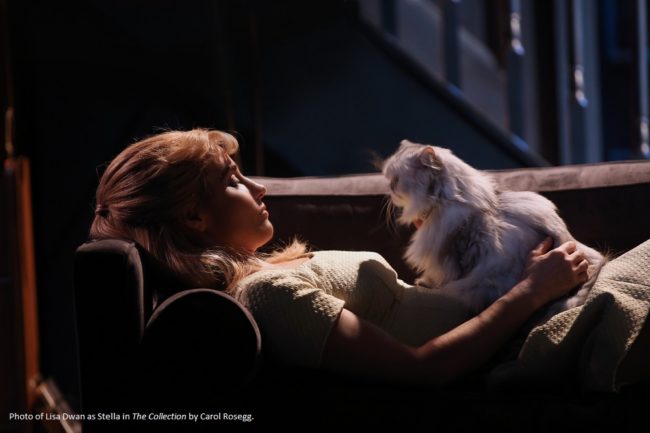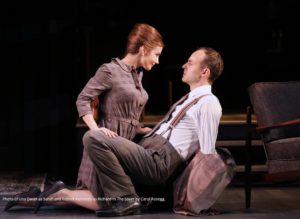Just who is who and what is what? Who’s lying? Who’s telling the truth? Scandal, lovers, mistresses, and then some await eager audiences of Washington DC as Shakespeare Theatre Company opens the 2017/2018 season with a double-bill of Harold Pinter. Artistic Director Michael Kahn brings The Lover & The Collection together for an evening inside the darkly scandalous and peculiarly humorous world of Pinter’s somewhat dated characters. Overlooking the misogyny and general banality of the female character featured in each of these productions, there is mystery and intrigue to be had among the burbling spikes of dramatic tensions. Twisting and warping the dynamic relationships that unfold throughout Pinter’s work, Kahn and a quartet of adept actors make an enjoyable evening, if you take it as is written in the period where it exists.
Constructing an elegant set that is primed for the 1950’s, Scenic Designer Debra Booth creates two unique spaces, one for each of the short plays. Both settings have a natural verve to them, feeling homey and quaint, almost piquant when closely examined. With the set for The Collector tucked away unseen behind the set for The Lover, there is mysterious intrigue as to just how one will transition into the other. Praise goes out to Stage Manager Kristy Matero and Assistant Stage Manager Rebecca Shipman and their run crew for the expedient and efficient transition between the two scenes over the tightly timed intermission. Lighting Designer Mary Louise Geiger augments the layout, especially during The Collector, as the scene is divided between Jimmy’s flat and the austere mansion parlor of Bill and Harry. Geiger even brightly highlights, via backlighting, the curious collection of vases inside the aforementioned posh dwelling, though regrettably, this collection has nothing to do with The Collection and almost appears to taunt and disorient the audience with so much light focused on it.

While Director Michael Kahn’s pacing is sharp, the overall feeling of the show polished, and the dramatic twists elevated to evoke a response, there is something lacking from the production as a whole. Perhaps it’s the way the pieces stay in their ascribed time period, though moving them forward in time would put the dramatic elements out of touch with reality (so much that in The Lover it would merely be addressed as polyamory or an open relationship and the drama would be alleviated entirely.) Or maybe it’s just the way that Pinter has penned his female characters in both pieces. Something slightly unnamable feels amiss but it is truly puzzling as to what. The running time of the production is perfectly aimed at today’s audiences, given the disinterest in the need for lengthy attention spans, the costumes (designed by Jane Greenwood) fit the time period, more noticeably so on the female characters, but are well suited all the same. The double bill is missing something, though damned if I know what.
Stealing the spotlight entirely during The Collection, is Sweet Bea, the silver-tipped Persian, who essentially exists as a prop-companion to the Stella character. There is something decadent and luxurious about Sweet Bea’s existence, serving her function as this beautiful lap cat. Sweet Bea is rarely seen, often being held by Stella in the shadowed-out low-lighting of the scene not active whilst the men perform some other interactions in the parlor on the right side of the stage. But the cat pulls focus simply by being elegant, almost creating a layer of Stella’s character that the audience would otherwise not get to see because of the way Pinter has penned the character in the script.

Both shows move smoothly, with The Lover being the edgier of the two pieces, delving deeply into the sensual and seductive territory of arranged infidelity. Primarily focused on Richard (Patrick Kennedy) and Sarah’s (Lisa Dwan) dissatisfying sexual relationship despite their blissful marriage, Michael Kahn does an extraordinary job of dispensing the gut-jerking plot twist so that isn’t clear to until the exacting finale. Kennedy is intensely disarming when going rogue with Dwan’s character in the middle of the production, even more so when he tangles his tongue around some of the more lurid imagery in a brash and accusatory fashion. The heightened dynamic between the pair is constantly fluctuating, rising and crashing to further explore the functional dysfunctions of their entanglements. Dwan delivers a delightful paced patois, appropriate for a British housewife in the mid-50’s, speaking eloquently and daintily, even when discussing her lover (credit here goes to Voice and Dialect Coach Lisa Beley.) The pair are quite extraordinary in the final moments of the production, the gob-smacking twist of a conclusion truly a surprise.
Kennedy goes on to play a rogue and almost thuggish sort of character in The Collector, going by James and Jimmy. One of the most impressive features of this production is again Geiger’s approach to the lighting, hiding figures in the telephone call box, obscuring them in shadow, as well as Sound Designer Veronica J. Lancaster’s muffled effect layered over the actors’ voices whenever they’re meant to be making phone calls from said callbox. With true grit Kennedy attacks the character of Jimmy with a protectiveness toward his wife, Stella (Lisa Dwan, whose character is virtually absent when it comes to lines spoken in this Pinter script.) This interactions pair delectably with the enigmatic Bill (Patrick Ball.)

Ball, who shares living quarters with the fusty and somewhat flamboyant Harry (Jack Koenig) character, is indeed a mystery. Even his sexual orientation seems to be lavishly disguised and depending on whether he’s teasing out a diabolically twisted tale with Kennedy’s character or playing lap-dog lackey to Koenig’s character he could find persuasion either way. Deliciously indescribable in the way he approaches the dramatic upswing of Pinter’s work in The Collector, it is Ball’s performance that keeps us invested in the peculiar plot as it unfurls. Koenig, who plays a secondary character to Ball’s Bill, is rather terse with Bill and the others once the plot unravels, though his shining moment is truly when he starts making his “slimy slug” comparisons.
Ultimately an enjoyable evening, though that distinctive feeling of “something lacking” is still readily present upon departing the theatre, Shakespeare Theatre Company’s double-bill of Harold Pinter’s The Lover & The Collector is an intriguing way to start the season.
Running Time: Approximately 2 hours and 10 minutes with one intermission
The Lover & The Collection play through October 29, 2017 at Shakespeare Theatre Company in the Lansburgh Theatre— 450 7th Street NW in the Penn Quarter—China Town neighborhood of Washington DC. For tickets call the box office at (20) 547-1122 or purchase them online.

